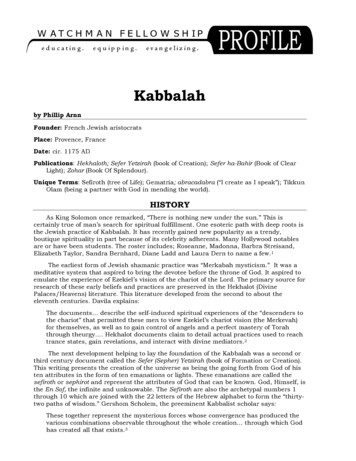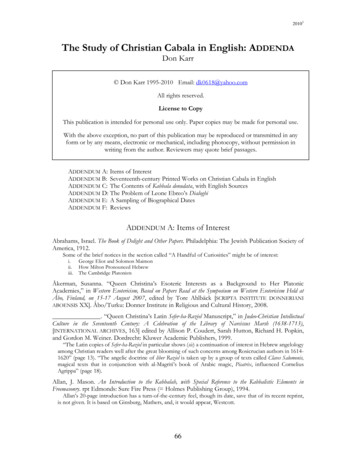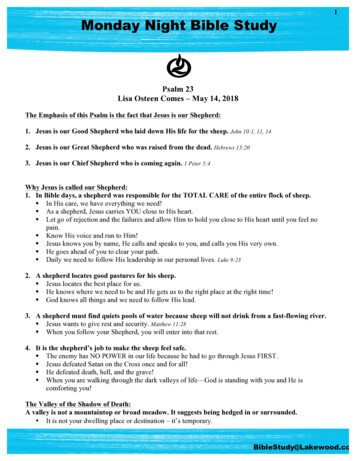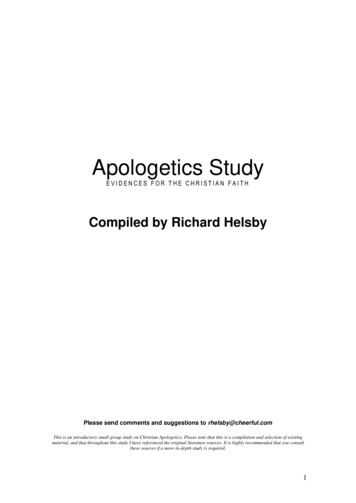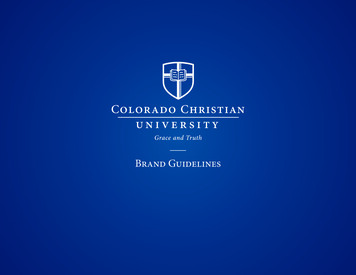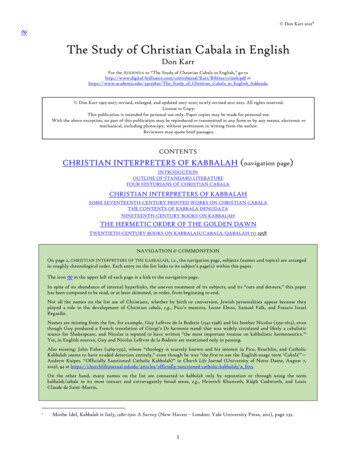
Transcription
Don Karr 2022R The Study of Christian Cabala in EnglishDon KarrFor the ADDENDA to “The Study of Christian Cabala in English,” go rr/Biblios/ccineb.pdf orhttps://www.academia.edu/24035820/The Study of Christian Cabala in English Addenda Don Karr 1995-2007; revised, enlarged, and updated 2007-2020; newly revised 2021-2022. All rights reserved.License to Copy:This publication is intended for personal use only. Paper copies may be made for personal use.With the above exception, no part of this publication may be reproduced or transmitted in any form or by any means, electronic ormechanical, including photocopy, without permission in writing from the author.Reviewers may quote brief passages.CONTENTSCHRISTIAN INTERPRETERS OF KABBALAH (navigation page)INTRODUCTIONOUTLINE OF STANDARD LITERATUREFOUR HISTORIANS OF CHRISTIAN CABALACHRISTIAN INTERPRETERS OF KABBALAHSOME SEVENTEENTH-CENTURY PRINTED WORKS ON CHRISTIAN CABALATHE CONTENTS OF KABBALA DENUDATANINETEENTH-CENTURY BOOKS ON KABBALAHTHE HERMETIC ORDER OF THE GOLDEN DAWNTWENTIETH-CENTURY BOOKS ON KABBALAH/CABALA/QABALAH TO 1958NAVIGATION & COMMONITIONOn page 2, CHRISTIAN INTERPRETERS OF THE KABBALAH, i.e., the navigation page, subjects (names and topics) are arrangedin roughly chronological order. Each entry on the list links to its subject’s page(s) within this paper.The icon in the upper left of each page is a link to the navigation page.In spite of its abundance of internal hyperlinks, the uneven treatment of its subjects, and its “cuts and detours,” this paperhas been composed to be read, or at least skimmed, in order, from beginning to end.Not all the names on the list are of Christians, whether by birth or conversion. Jewish personalities appear because theyplayed a role in the development of Christian cabala, e.g., Pico’s mentors, Leone Ebreo, Samuel Falk, and Francis IsraelRegardie.Names are missing from the list, for example, Guy Lefèvre de la Boderie (1541-1598) and his brother Nicolas (1550-1613), eventhough Guy produced a French translation of Giorgi’s De harmonia mundi that was widely circulated and likely a cabalisticsource for Shakespeare, and Nicolas is reputed to have written “the most important treatise on kabbalistic hermeneutics.”1Yet, in English sources, Guy and Nicolas Lefèvre de la Boderie are mentioned only in passing.Also missing: John Fisher (1469-1535), whose “theology is scarcely known and his interest in Pico, Reuchlin, and CatholicKabbalah seems to have evaded detection entirely,” even though he was “the first to use the English-usage term ‘Cabala’”—Andrew Kuiper, “Officially Sanctioned Catholic Kabbalah?” in Church Life Journal (University of Notre Dame, August 7,2019), §4 at ly-sanctioned-catholic-kabbalah/# ftn5.On the other hand, many names on the list are connected to kabbalah only by reputation or through using the termkabbalah/cabala in its most inexact and extravagantly broad sense, e.g., Heinrich Khunrath, Ralph Cudworth, and LouisClaude de Saint-Martin.1Moshe Idel, Kabbalah in Italy, 1280-1510: A Survey (New Haven – London: Yale University Press, 2011), page 232.1
Don Karr 2022R CHRISTIAN INTERPRETERS OF THE KABBALAHNAVIGATION PAGENames marked with an asterisk (*) have entries in Dictionary of Gnosis & Western Esotericism, edited by Wouter Hanegraaffin collaboration with Antoine Faivre, Roelof van den Broek, and Jean-Pierre Brach (Leiden – Boston: Brill, 5.36.37.38.39.40.41.42.43.44.45.RAMON LLULL* 1232-1316DANTE ALIGHIERI* 1265-1321ABNER OF BURGOS 1270-1348PAULUS [PABLO] DE HEREDIA CA. 1405-1486LODOVICO LAZZARELLI* 1447-1500GIOVANNI PICO DELLA MIRANDOLA* 1463-1494PICO’S MENTORSJOHANNES REUCHLIN* 1455-1522JACQUES LEFÈVRE D’ÉTAPLES* CA. 1455-1536PETRUS GALATINUS* CA. 1460-CA. 1540LEONE EBREO CA. 1460-CA. 1530JOHANNES TRITHEMIUS* 1462-1516FRANCESCO GIORGI* 1466-1540EGIDIO DA VITERBO* 1469-1532AGOSTINO GIUSTINIANI 1470-1536ALBRECHT DÜRER 1471-1528JEAN THÉNAUD CA. 1480-CA. 1485PAUL RICIUS 1480-CA.1542GIULIO CAMILLO* 1480-1544HEINRICH CORNELIUS AGRIPPA* 1486-1535PARACELSUS* 1493-1541ARCHANGELUS OF BURGO NUOVO D. CA. 1570JOHANN ALBRECHT WIDMANSTETTER 1506-1557GUILLAUME POSTEL* 1510-1581TERESA OF AVILA 1515-1582JOHN DEE* 1527-1608ENOCHIAN MAGICLUIS DE LEÓN CA. 1538-1591JUAN DE LA CRUZ 1542-1591JEAN BODIN 1530-1596JOHANN PISTORIUS 1546-1608GIORDANO BRUNO* 1548-1600HEINRICH KHUNRATH* CA. 1560-1605THE CONFLATION OF CABALA & ALCHEMYWILLIAM SHAKESPEARE 1564-1616JOHANNES BUREUS 1568-1652PAUL YVON 1570-1646JOHN DONNE 1572-1631ROBERT FLUDD* 1574-1637JACOB BÖHME* 1575-1624JACQUES GAFFAREL 1601-1681ATHANASIUS KIRCHER* 1602-1680J. S. RITTANGEL [RITTANGELIUS] 1606-1652JOHN MILTON 1608-1674ANTONIA OF WÜRTEMBERG 1613-1679THOMAS VAUGHAN* 1622-1695FRANCIS MERCURY VAN HELMONT* .60.61.62.63.64.65.66.67.68.69.70.CHRISTIAN KNORR VON ROSENROTH* 1636-1689THE CAMBRIDGE PLATONISTSHENRY MORE* 1614-1687RALPH CUDWORTH* 1617--1688ANNE CONWAY 1631-1679THOMAS BURNET 1635-1715ISAAC NEWTON* 1642-1726 OR 1727GOTTFRIED LEIBNIZ 1646-171617TH-CENTURY PRINTED WORKS ON CHRISTIAN CABALATHE CONTENTS OF KABBALA DENUDATAKABBALAH IN COLONIAL AMERICAJOHAN KEMPER 1670-1716THE ‘UNKNOWN SUPERIORS’EMANUEL SWEDENBORG* 1688-1772SAMUEL FALK* 1710-1782ALESSANDRO CAGLIOSTRO* 1743-1795FRIEDRICH CHRISTOPH OETINGER* 1702-1782LOUIS CLAUDE DE SAINT-MARTIN* 1743-01803WILLIAM BLAKE* 1757-1827GEORG WILHELM FRIEDRICH HEGEL 1770-1831FRANCIS BARRETT* CA. 1775-18?FRANZ JOSEF MOLITOR 1779-1860DAVID-PAUL DRACH 1791-1865ALPHONSE LOUIS CONSTANT [ÉLIPHAS LÉVI]* 1810-1875ALBERT PIKE 1809-1891HARGRAVE JENNINGS* 1817-1890SETH PANCOAST 1823-1889HELENA PETROVNA BLAVATSKY* 1831-1891ALBERT JOUNET [ALBER JHOUNEY] 1863-1923GERARD ENCAUSSE [PAPUS]* 1865-191619TH-CENTURY BOOKSTHE HERMETIC ORDER OF THE GOLDEN DAWN71. WILLIAM WYNN WESTCOTT* 1848-192572. S. L. MACGREGOR MATHERS* 1854-191873. HENRY B. PULLEN-BURRY 1855-192674. ARTHUR E. WAITE* 1857-194275. FLORENCE FARR 1860-191776. WILLIAM WILLIAMS [NURHO DE MANHAR] FL. 1888-191477. W. B. YEATS 1865-193978. ALEISTER CROWLEY* 1875-194779. CHARLES STANSFELD JONES [FRATER ACHAD] 1886-1950KENNETH GRANT/O.T.O.80. CHARLES WILLIAMS 1886-194581. VIOLET MARY FIRTH [DION FORTUNE]* 1890-195082. FRANCIS ISRAEL REGARDIE 1907-198520TH-CENTURY BOOKSThe article, “Christian Kabbalah,” at WIKIPEDIA identifies ten “Christian Kabbalists” (see below, page 132), three of whom arenot listed above: BALTHASAR WALTHER (1558-CA. 1631), who is discussed in my entry on JACOB BÖHME. The WIKIPEDIA article cites Leigh T. I. Penman’s paper,“A Second Christian Rosencreuz?”—my source as well.SIR THOMAS BROWNE (1605-1682), whom I have not encountered in the course of my research. The WIKIPEDIA article refers to Reid Barbour’sbook, Sir Thomas Browne: A Life (Oxford: Oxford University Press, 2013). Therein, cabala is mentioned only in passing as “the fancies ofCabala” and simply “Cabala” (—pages 338 and 360) within lists of topics which Browne touched upon in his writings.ADORJÁN CZIPLEÁ (1639-1664), whom I have not encountered in the course of my research. The WIKIPEDIA article refers the reader to its ownpage on Czipleá, which contains neither notes nor links to sources. Further, the article refers to but one “short treatise” by Czipleá whichis lost. References indicate that Czipleá’s cabala was derived from familiar names within the first wave of Christian kabbalah, namely Picoand Reuchlin, and a slightly later influence, John Dee.2
Don Karr 2022R2 INTRODUCTIONANYONE WHO HAS read a few books concerning the Western esoteric tradition has encountered, at thevery least, references to kabbalah, variously cabala, or qabalah.2 A familiarity with the term kabbalah andthe implications of the variant spellings of the word as cabala and qabalah is useful here. Very broadly, kabbalah generally represents Jewish esoteric teaching which emerged in the 12th century, thoughpreserving older mystical elements; it is a grand commentary on the Torah elaborating on the relationshipof man and the infinite creator. cabala is something of a catch-all for both Christian interpretations of kabbalah from the Renaissance andReformation periods and magic in general, such as that described by Heinrich Cornelius Agrippa (14861535). qabalah is “Hermetic”3 in that it is the narrow practical version of kabbalah originating in nineteenthcentury Western esoteric schools such as the Golden Dawn the structure of which is centered on thekabbalistic Tree of Life and its correspondences to other schemes, especially the tarot.These days, academics seem to favor kabbalah for all references, drawing distinctions by adding themodifiers “Christian” or “Hermetic.”Cabala figures into many tenets and methods central to Western esoteric thought and practice.Unfortunately, what is meant by term is not always clear and may vary from one reference to another.Those readers who enter an investigation of Christian cabala after having studied Jewish kabbalah maywell become impatient at the outset with the misreadings and deformations characteristic of “Christiandevelopments.”4Complicating matters further, Christian ideas seem to have crept into (Jewish) kabbalah. Regarding kabbalistic developments in the 12th century, Elliot R. Wolfson suggests that the motif of the cosmictree, an image that became central to kabbalah as the Tree of Life (etz hayyim—the tree of the sefirot), combinesJewish and Christian influences.52345On “the background of variant orthographies, including origins, definitions, and usages,” see Anthony J. Elia, “AnHistorical Assessment of the Narrative Uses of the Words ‘Kabbalah,’ ‘Cabala,’ and ‘Qabala/h’: Discerning theDifferences for Theological Libraries,” in Theological Librarianship: An Online Journal of the American Theological LibraryAssociation, Volume 2, Number 2 (Chicago: American Theological Society, 2009), at THEOLOGICAL LIBRARIANSHIP:Vol. 2 No. 2 (2009) Theological Librarianship (atla.com)Frances Yates coined the term “Hermetic-Cabalist tradition” to refer to the Christian stream begun by Pico and Reuchlin,which incorporated a blend of the literature attributed to Hermes Trismegistus, Platonism, and what was perceived askabbalah. Thus, it is equivalent to the second category above: cabala.For a summary of the differences between Jewish kabbalah and Christian cabala, especially with regard to the latter’s earlieststages, see(1) Joseph Dan, “Christian Kabbalah: From Mysticism to Esotericism,” in Western Esotericism and the Science of Religion,eds. Antoine Faivre and Wouter J. Hanegraaff [GNOSTICA 2] (Leuven: Peeters, 1998), pp. 117-129; reprinted in Dan’sJewish Mysticism, Volume III: THE MODERN PERIOD (Northvale – Jerusalem: Jason Aronson Inc., 1999), pp. 191-207.(2) the first several sections of Dan’s article, “The Kabbalah of Johannes Reuchlin and Its Historical Significance,” inThe Christian Kabbalah: Jewish Mystical Books and Their Christian Interpreters, ed. Joseph Dan (Cambridge: HarvardCollege Library, 1997), also reprinted in Dan’s Jewish Mysticism, Volume III, pp. 209-251.(3) Moshe Idel, “Jewish Kabbalah in Christian Garb,” in Kabbalah in Italy, 1280-1510: A Survey (New Haven – London:Yale University Press, 2011), pp. 227-235“The Tree That is All: Jewish-Christian Roots of a Kabbalistic Symbol in Sefer ha-Bahir,” in Journal of Jewish Thought andPhilosophy, volume 3, issue 1, edited by Elliot Wolfson and Paul Mendes-Flohr (Harwood Academic Publishers GmbH,1993), pp. 31-76; reprinted in Along the Path: Studies in Kabbalistic Myth, Symbolism, and Hermeneutics (Albany: StateUniversity of New York Press, 1995), pp. 63-88.While raising the issues of Christian influences on (Jewish) kabbalah, Wolfson calls into question traditional lines ofinquiry into a particular subject matter, namely, the ten sefirot, as the major indication of the origins of kabbalah. He says,in effect, that if Sefer ha-Bahir is the earliest known work which can properly be called kabbalistic, its own contents suggestthat something more—if not something other—than the sefirot comprises kabbalah’s primal swirlings.3
Don Karr 2022R2 Peter Schäfer indicates connections between the Christian figure of Mary and kabbalistic notions of theshekhinah (the “presence of God”) as a deific female, an object of devotion, and a mediator between God andman.6 Yehuda Liebes has demonstrated that the Zohar’s “Doctrine of Trinity,” concepts of the “Son,” andinterpretations of GENESIS 1:1 betray signs of Christian thought,7 though he qualifies his observations, stating,[A]lthough the author of the Zohar allowed himself to be influenced by Christianity, this does notmean that he felt any affinity for the “Gentile Nations,” and particularly for those who converted totheir faith. Quite the opposite is true.8Indeed, Ellen D. Haskell has shown how the author(s) of the Zohar “crafted strategically subversive narrativesthat bolstered Jewish identity by countering Christian claims.”9The strand of Christian cabala which has become best known began in Renaissance Florence withGiovanni Pico della Mirandola (1463-1494). Pico sought to harmonize Christian beliefs with cabala,which he considered a primal form of Jewish doctrine which originated with Moses and thus longpresaged the teachings of Jesus. This parallels the treatment of the Hermetica by the circle around Ficino,namely the movement to recover the prisca theologia (the ancient theology) and philosophia perennis (theperennial philosophy), thought to be the fountainheads of all true religion and philosophy.10 Certainly,the “first wave” of Christian kabbalists in the Renaissance (Pico della Mirandola, Johannes Reuchlin,Francisco Giorgi, Egidio da Viterbo, Agrippa, etc.) viewed cabala as an expression of Christian truthentrusted to the Jews centuries before Christ’s incarnation.11 These interpreters took cabala as anindependent tradition that transcended Judaism.12678910Moshe Idel broaches the same point at the beginning of “Jewish Kabbalah in Christian Garb” (cited in the previousfootnote), mentioning “an esoteric tradition concerning divine names” as another possible early indication of kabbalah(ibid., page 227). Idel also takes up this issue in “Defining Kabbalah: The Kabbalah of the Divine Names,” in Mystics of theBook: Themes, Topics and Typologies, edited by R. A. Herrera (New York – San Francisco – Bern, etc.: Peter Lang, 1993), pp.97-122.Mirror of His Beauty: Feminine Images of God from the Bible to the Early Kabbalah (Princeton – Oxford: Princeton UniversityPress, 2002).Studies in the Zohar (Albany: State University of New York Press, 1993), pp. 139-161Ibid., page 139.Mystical Resistance: Uncovering the Zohar’s Conversations with Christianity (New York: Oxford University Press, 2016), page 1.Also see Jonatan Benarroch’s articles, (1) “God and His Son: Christian Affinities in the Shaping of the Sava and YanukaFigures in the Zohar,” in the Jewish Quarterly Review, Volume 107, Number 1 (University of Pennsylvania Press, 2017),pages 38-65; and (2) “‘The Mystery of (Re)Incarnation and the Fallen Angels’: The Reincarnations of Adam, Enoch,Metatron, (Jesus), and Joseph—an Anti-Christian Polemic in the Zohar,” in Journal of Medieval Religious Cultures, Vol. 44,No. 2 (University Park: The Pennsylvania State University, 2018), pp. 117-147.See D. P. Walker, The Ancient Theology (Ithaca: Cornell University Press, 1972); and Jerome Friedman, The Most AncientTestimony: Sixteenth-Century Christian-Hebraica in the Age of Renaissance Nostalgia (Athens: Ohio University Press, 1983).The Ancient Theology is a series of articles examining the influence and use of the prisca theologia, ancient theology, asderived from the Hermetica and related material, writings of the first four-hundred or so years of the common era whichwere believed to be—until Isaac Casaubon’s “convincingly thorough scholarship (in 1614) showed otherwise”—of greatantiquity and, indeed, the fountainhead of the world’s religions and philosophies.1112On the “first wave” of Christian kabbalists, see my “Ésotérisme et Kabbale chrétienne,” in Histoire comparée des littératuresde langues européennes, SOUS-SÉRIE RENAISSANCE, Volume II: La Nouvelle Culture – 1480-1520, ed. Eva Kushner (Budapest:Akadémiai Kiadó/Amsterdam: John Benjamins B. V., 2017), pp. 47-56; for the English version, “Esotericism and ChristianKabbalah: 1480-1520,” link to either of the following URLs: /KS/ECK.pdf https://www.academia.edu/34425754/Esotericism and the Christian Kabbalah 1480-1520 - full textEven within Judaism, some developments of later kabbalah (16th century and after) spun free of dependence on the Torah.The Zohar was a supposed commentary on the Torah, and Lurianic kabbalah was a commentary on the Zohar. HayyimVital, whose writings are among the most important representations of Lurianic kabbalah, “restlessly recast the essentialLurianic doctrine in ways that increasingly abandoned the Zohar as proof text” (—Pinchas Giller, Reading the Zohar [Oxford– New York: Oxford University Press, 2001], p. 23).4
Don Karr 2022R2 Ideally, we would find sources which led us in a nice straight line from the traditional beginning of theChristian cabala in the Renaissance to the present day. Alas, the material available on the subject and thehistory of Christian cabala itself conspire to make our effort one fraught with cuts and detours, though acertain shape to it all does emerge.At the outset, the limitations of an English-only bibliography should be noted, for any short list of bookson Christian cabala consists largely of works in other languages.A selection of standard works—listed chronologically—would include Benz, Ernst. Die christliche Kabbala: Ein Stiefkind der Theologie [THE CHRISTIAN KABBALAH: A STEPCHILDOF THEOLOGY] (Zürich: Rhein-Verlag, 1958). Secret, François. Le Zôhar chez les kabbalistes chrétiens de la Renaissance (Paris: Durlacher, 1958). Secret, François. Les Kabbalistes chrétiens de la Renaissance (Paris: Dunod, 1964). Wirszubski, Chaïm. Sheloshah perakim be-toldot ha-Kabalah ha-notsrit [THREE STUDIES IN THE HISTORY OFCHRISTIAN KABBALAH] (Jerusalem: Mosad Bialik, 1975).Studies on Pico della Mirandola. Gorny, Leon. La Kabbale: Kabbale juive et cabale chrétiennes (Paris: Pierre Belfond, 1977). Wirszubski, Chaïm. Mekubal be-Notsri Kore ba-Torah [A CHRISTIAN KABBALIST READS(Jerusalem: Mosad Bialik, 1977).THELAW]The “Christian Kabbalist” here is Giovanni Pico della Mirandola. Kabbalistes chrétiens, eds. Antoine Faivre and Frédérick Tristan [series CAHIERS DE L’HERMÉTISME](Paris: Albin Michel, 1979). Wirszubski, Chaïm. Ben ha-shtin : Kabalah, Kabalah Notsrit, Shabta’ut [BETWEEN THE LINES: KABBALAH,CHRISTIAN KABBALAH, AND SABBATEANISM] (Jerusalem: The Magnes Press/Hebrew University, 1990). Secret, François. Hermetisme et Kabbale [LEZIONI DELLA SCUOLA DI STUDI SUPERIORI IN NAPOLI 15](Naples: L’Istituto Italiano per gli Studi Filosofici, 1992). Kilcher, Andreas. Die Sprachtheorie der Kabbala als ästhetisches Paradigma: Die Konstruktion einerästhetischen Kabbala seit der Frühen Neuzeit [THE LINGUISTIC THEORY OF KABBALAH AS AN AESTHETICPARADIGM: THE CONSTRUCTION OF AN AESTHETIC KABBALAH SINCE THE EARLY MODERN PERIOD] (Stuttgart- Weimar: Verlag J. B. Meltzer, 1998).For an English summary of Die Sprachtheorie der Kabbala , see Elke Morlok’s review in Kabbalah: Journalfor the Study of Jewish Mystical Texts, Volume Seven, eds. Daniel Abrams and Avraham Elqayam (LosAngeles: Cherub Press, 2002), pp. 67-77. Christliche Kabbala, ed. Wilhelm Schmidt-Biggemann (Ostfildern: Jan Thorbecke Verlag, 2003).Contains papers in French (1), German (13), and English (2). The English articles are Sarah Hutton’s“From Christian Kabalism to Kabalistic Quakerism: The Kabalistic Dialogues of Anne Conway, HenryMore, and George Keith,” and Moshe Idel’s “Jewish Thinkers versus Christian Kabbalah.” Schmidt-Biggermann, Wilhelm. Geschichte der christlichen Kabbala [HISTORY OF THE CHRISTIANKABBALAH] [CLAVIS PANSOPHIAE 10], vier Bände [FOUR VOLUMES] (Stuttgart: frommann-HolzboogVerlag e.K., 2012-2014).- Band 1. 15. und 16. Jahrhundert [FIFTEENTH AND SIXTEENTH CENTURIES - Pico to Pistorius]- Band 2. 1600-1660 [Böhme, Franckenberg, Khunrath, Fludd, the translation of Sefer Yetzirah by Stephan Rittangel(1642)]- Band 3. 1660-1850 [Kabbala denudata and thereafter]- Band 4. BibliographieSubsequent Luria-based kabbalists, e.g., Moshe Hayyim Luzzatto (author of Kelah Pithei Hokhmah) and Shneur Zalman ofLyady (author of Likkutei Amarim, called the Tanya), offered bodies of teachings that are even further removed fromScripture.5
Don Karr 2022R2 Standard works in English include the following (listed chronologically),13 five of which are discussed insome detail below (follow the links): Blau, Joseph L. Christian Interpretation of the Cabala in the Renaissance (New York: ColumbiaUniversity Press, 1944; Port Washington: Kennikat Press, 1965)—BLAU. Yates, Frances. Giordano Bruno and the Hermetic Tradition (Chicago: University of Chicago Press, 1964& 1991)—YATESGB. . Occult Philosophy in the Elizabethan Age (London: Routledge and Kegan Paul, 1979 & 2001)—YATESOP. Joseph Dan (ed.) The Christian Kabbalah: Jewish Mystical Books and Their Christian Interpreters(Cambridge: Houghton Library of the Harvard College Library, 1997/1998).Contributors: Gershom Scholem, Joseph Dan, Giulio Busi, Klaus Reichert, Allison Coudert, and HillelLevine. Beitchman, Philip. Alchemy of the Word: Cabala of the Renaissance (Albany: State University of NewYork Press, 1998)—BEITCHMAN. Benz, Ernst. Christian Kabbalah (St. Paul: Grailstone Press, 2004) a translation of Die christlicheKabbala: Ein Stiefkind der Theologie (Zürich: Rhein-Verlag, 1958)—BENZ.13In spite of its “assertive title” (—the author’s term, p. ii), The Rape of Jewish Mysticism by Christian Theologians by RobertWang (Columbia [MD]: Marcus Aurelius Press, 2001) is a rather drab summary of well-known—and well-worn—sources.Moreover, Wang does not really engage his thesis (i.e., the rape of Jewish mysticism) anywhere through the book save thepreface and the brief conclusion. The book comes to an anticlimactic halt with “Christian Kabbalah becomesRosicrucianism,” “The Fama Fraternitas,” and “Robert Fludd.” Wang’s omission of developments through the 17th-19thcenturies is all the more puzzling given the book’s subtitle, How the Modern Occult Movement Grew out of RenaissanceAttempts to Convert the Jews.See my detailed discussion of Wang’s Rape of Jewish Mysticism in ADDENDUM B, Reviews (a link to the URL for theADDENDA is given at the head of this paper), and, in a less clear format, which seems purposely buried, at Esoterica: TheJournal of Esoteric Studies, Volume VI, ed. Arthur Versluis (East Lansing: Michigan State University, 2004), hristian Kabbalists: John Donne, Giordano Bruno, Ramon Llull, Paracelsus, Athanasius Kircher, Robert Fludd, Giovani Pico dellaMirandola (Memphis: Books LLC, 2010) offers incomplete reprints of WIKIPEDIA articles with an index. The articles aresketchy and inconsistent, some showing no connection with cabala whatsoever. The same description could apply to TheEsoteric Codex: Christian Kabbalah by Sarai Kasik (Lulu.com, 2015), though this book offers numerous illustrations.6
Don Karr 2022R2 SOME USEFUL INTRODUCTORY BOOKS, CHAPTERS & ARTICLESLISTED CHRONOLOGICALLY Thorndike, Lynn. History of Magic & Experimental Science (New York – London, ColumbiaUniversity Press, 1923-1958).Refer below to Thorndike within A SELECTION OF TWENTIETH-CENTURY BOOKS. Schuchard, Marsha Keith. “The Christian Interpretation of the Cabala in the Renaissance, and theDevelopment of the Syncretic Occult Tradition,” CHAPTER II of FREEMASONRY, SECRET SOCIETIES,AND THE CONTINUITY OF THE OCCULT TRADITIONS IN ENGLISH LITERATURE (Ph.D. diss. University ofTexas at Austin, 1975). Swietlicki, Catherine. “Christian Cabala in the Renaissance” and “The Diffusion of ChristianCabala in Renaissance Culture” CHAPTERS 1 and 2 of Spanish Christian Cabala (Columbia:University of Missouri Press, 1986), pp. 1-42—based primarily on François Secret, Frances Yates, andGershom Scholem. Manuel, Frank E. The Broken Staff: Judaism through Christian Eyes (Cambridge – London: HarvardUniversity Press, 1992), especially CHAPTER 3, §§ “Pico della Mirandola and His Mentors” (pp. 37-44)and “Johannes Reuchlin in Defense of the Talmud” (pp. 44-46). Masters, G. Mallary. “Renaissance Kabbalah,” in Modern Esoteric Spirituality, eds. Antoine Faivre andJacob Needleman (New York: Crossroad Publishing, 1995), pp. 132-153. Wouter J. Hanegraaff’s historical outline of “traditional esotericism” (CHAPTER 14, especially § C,“The Components of Western Esotericism”) in New Age Religion & Western Culture (Leiden: E. J.Brill, 1996), pp. 388-396. Dan, Joseph. “Christian Kabbalah: From Mysticism to Esotericism,” in Western Esotericism and theScience of Religion, eds. Antoine Faivre & Wouter J. Hanegraaff [GNOSTICA 2] (Leuven: Peeters,1998), pp. 117-129; reprinted in Dan’s Jewish Mysticism, Volume III: THE MODERN PERIOD (Northvale– Jerusalem: Jason Aronson Inc., 1999), pp. 191-207. Faivre, Antoine. “Renaissance Hermeticism and the Concept of Western Esotericism” in Gnosis andHermeticism, edited by Roelof van den Broek and Wouter J. Hanegraaff (Albany: State University ofNew York Press, 1998), pp. 109-123. Idel, Moshe. “Reflections on Kabbalah in Spain and Christian Kabbalah,” in Hispania Judaica Bulletin,#2 (Jerusalem: Hebrew University of Jerusalem, 1999), pp. 3-15. Laenen, J. H. “Popular Literature on ‘Kabbalah’” CHAPTER 8 of Jewish Mysticism: An Introduction(Louisville: Westminster John Knox Press, 2001), pp. 263-272. Dictionary of Gnosis & Western Esotericism, edited by Wouter Hanegraaff in collaboration withAntoine Faivre, Roelof van den Broek, and Jean-Pierre Brach (Leiden – Boston: Brill, 2005), VOLUMEII: § “Jewish Influences,”14 especially PART III: “‘Christian Kabbalah’ in the Renaissance” (pp. 638642), PART IV: Enlightenment / Romanticism” (pp. 642-644), and PART V: Occultist Kabbalah” (pp.644-647).14The debt that the early Christian cabalists owe to Jewish teachers should not be overlooked. In a discussion of theRenaissance period, Eisig Silberschlag writes:Many outstanding teachers who taught some eminent Christians were in the forefront of their age: Mauele da S.Miniato, the erudite banker and teacher of the Florentine statesman Giannozzo Manetti; the philosophicalscholars Elijah del Medigo and Yohanan Alemanno, teachers of Giovanni Pico della Mirandola; Obadiah Sforno,the physician, the commentator on the Pentateuch and the teacher of Johannes Reuchlin; Elijah Levita, theitinerant scholar, grammarian and teacher to such eminent personalities as Edigio da Viterbo, the General of theOrder of the Hermits of Saint Augustine, who became cardinal in 1517, Mario Grimani, the patriarch of Aquila,George de Selve, bishop of Lavaur, Sebastian Münster, the humanist of Basle and Paul Fagius, the reformedminister; Leone Modena who taught Giovanni Vislingio, professor of anatomy in Padua, Vincenzo Noghera, thescholarly Theologian.—From Renaissance to Renaissance (New York: Ktav Publishing House, 1973)—pp. 3-4.7
Don Karr 2022R2 Stuckrad, Kocku von. “Esotericism in the Confessional Age,” CHAPTER 5 of Western Esotericism: ABrief History of Secret Knowledge (London – Oakville: Equinox Publishing Ltd, 2005), pp. 62-98;CHAPTER 3, pp. 31-43, outlines major developments in Jewish Kabbalah. Dan, Joseph. “Modern Times I: The Christian Kabbalah” CHAPTER 5 of Kabbalah: A Very ShortIntroduction (Oxford – New York: Oxford University Press, 2006), pp. 61-69. Smoley, Richard. “The Sages of the Renaissance” CHAPTER 6 of Forbidden Faith: The Gnostic Legacyfrom the Gospel to the Da Vinci Code (San Francisco: HarperSanFrancisco, 2006), pp. 107-123. Bogdan, Henrik. Western Esotericism and Rituals of Initiation (Albany: State University of New YorkPress, 2007); see in particular CHAPTER 3, “Historical Background” (pp. 53-52), and the last section ofCHAPTER 4 (pp. 89-93). Smith, Wolfgang. “The Wisdom of Christian Kabbalah,” in Sophia: The Journal of Traditional Studies,Volume 13, Number 2 (Oakton [VA]: The Foundation for Traditional Studies, Winter 2007-2008),pages 41-67. Goodrick-Clarke, Nicholas. “Italian Renaissance Magic and Cabala” CHAPTER 2 of The WesternEsoteric Traditions: A Historical Introduction (Oxford: Oxford University Press, 2008), pp. 33-47. Levenda, Peter. “Christian Kabbalah and the Esoteric Orders” CHAPTER 10 of Stairway to Heaven:Chinese Alchemists, Jewish Kabbalists, and the Art of Spiritual Transformation (New York – London:Continuum, 2008), pp. 146-179. Stuckrad, Kocku von. “The Secrets of Texts: Esoteric Hermeneutics” CHAPTER FIVE of Locations ofKnowledge in Medieval and Early Modern Europe: Esoteric Discourse and Western Identities [BRILL’SSTUDIES IN INTELLECTUAL HISTORY 186] (Leiden – Boston: Brill, 2010), especially § “LinguisticOntologies in Christian Kabbalah,” pp. 103-110. Coudert, Allison P. “Christian Kabbalah,” in Jewish Mysticism and Kabbalah: New Insights andScholarship, ed. Frederick E. Greenspahn (New York – London: New York University Press, 2011),pp. 159-172. Idel, Moshe. “Jewish Kabbalah in Christian Garb” CHAPTER 19 of Kabbalah in Italy, 1280-1510: ASurvey (New Haven – London: Yale University Press, 2011), pp. 227-235. Rosicrucian Digest, Vol. 90, No. 2: KABBALAH (San Jose: Rosicrucian Order AMORC, 2012); contains amix of Jewish and Christian occult kabbalah with articles from a broad spectrum of authors: fromPapus and Ralph M. Lewis to Nicholas Goodrick-Clarke and Daniel C. Matt. Forshaw,
NINETEENTH-CENTURY BOOKS ON KABBALAH . TWENTIETH-CENTURY BOOKS ON KABBALAH/CABALA/QABALAH TO 1958 NAVIGATION & COMMONITION On page 2, CHRISTIAN INTERPRETERS OF THE KABBALAH, i.e., the navigation page, subjects (names and topics) are arranged . "Christian Kabbalah: From Mysticism to Esotericism," in , ," in . cabala cabala, .

